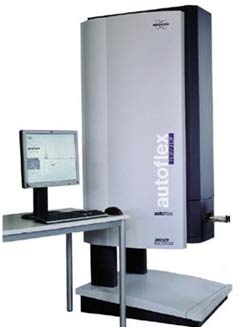ICB&DD Mass Spectrometry Laboratory, Lab 576 & 570, Chemistry Bldg.
FOR SUBMISSION OF SAMPLES FOR MASSPEC ANALYSIS

The Institute of Chemical Biology and Drug Discovery (ICB&DD) operates an Analytical Instrumentation Laboratory in the Chemistry department at SUNY-Stony Brook. This laboratory consists of three mass spectrometers at present.
Two of these instruments are located in Lab 576 and are available to approved, qualified users on a 24/7 basis.
1) The first instrument is an Agilent LC-MSD acquired in 2004. It consists of an 1100 HPLC and a G1956A mass spectrometer. The 1100 HPLC provides liquid solvent delivery to the electrospray ionization (ESI) source of the mass spectrometer. The mass analyzer is a single quadrupole providing MS capabilities with unit resolution over the m/z range 50-1500Da. The instrument is used primarily in the direct-inject mode for preliminary product identification and verification by synthetic chemists for reaction monitoring. The instrument may also be used for sample purity analysis in the LC-MS (scan) mode and for quantitative measurements in the LC-MS single-ion monitoring (SIM) mode. The Agilent data analysis software has a simple, deconvolution option that provides for deconvolution of the multi-charge state mass spectrum that results from protein ionization in the ESI source. Therefore the purity and average molecular weight of proteins, up to 66kDa, has been determined with this instrument.
2) The second instrument is a Bruker AutoFlexII acquired in 2005. The mass spectrometer consists of a MALDI ionization source for samples in the solid state and a TOF/TOF mass analyzer. The mass analyzer operating in the low-resolution, linear mode provides an m/z range of 50-300,000Da and in the high-resolution, reflectron mode, a range of m/z=50-6,000Da. The instrument is typically used for measurement of biopolymers such as synthetic peptides, dendrimers, proteins, protein digests, oligonucleotides and glycans. The instrument was designed primarily for protein characterization by: 1)high-resolution (15000), monoisotopic mass measurement of peptides, in the range 700-3500Da, resulting from protein digests to give peptide mass fingerprinting (PMF) protein identification, and 2)MS/MS peptide sequencing measured by peptide fragments produced by post-source decay (PSD) and resolved by the TOF/TOF mass analyzer.
The third MS instrument, located in Lab 570, is an Agilent LC-UV-TOF and was acquired in 2012. It consists of a 1260 uPLC, a UV-Vis diode-array detector (DAD) and a TOF mass analyzer. The DAD provides wavelength measurements from 190-800nm with a 20Hz acquisition rate. The mass spectrometer is a G6224A oaTOF model. It provides MS capabilities in the range m/z=100-20,000. It is typically operated in MS mode in the range m/z=100-3200 while maintaining a resolution of 20,000 at m/z= 1,522 and acquiring 20 spectra/sec with an accuracy of <2ppm. The instrument has two possible ionization sources: 1) an ESI source and 2) a MultiMode source consisting of combined ESI and APCI ionization modes. Both sources have dual inlets allowing for internal reference mass calibration to achieve <2ppm mass accuracy. The instrument is used exclusively for accurate mass determination, formula verification and sample purity analysis for small molecules and biopolymers.
